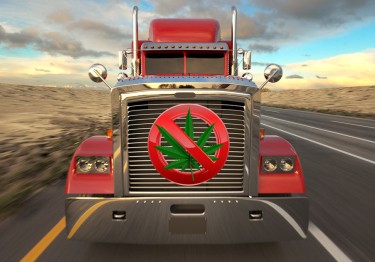The utilization of drugs by commercial truck drivers has reached a peak not seen since 2019, and the American Transportation Research Institute (ATRI) is determined to uncover the reasons behind it. ATRI is embarking on a mission to gather information from carriers on safety and related concerns arising from the legalization of marijuana at the state level. ATRI aims to unravel the mystery surrounding the upsurge in drug use among commercial truck drivers through a series of questions.
ATRI's previous research has revealed a connection between the rise in drivers operating under the influence and the enactment of laws legalizing recreational marijuana. In light of these findings, the ATRI Research Advisory Committee is poised to delve deeper into the implications of recreational marijuana use. With a renewed focus on this issue, the committee aims to uncover vital insights into the impact of recreational marijuana legalization on road safety.
As of December 2022, the Drug and Alcohol Clearinghouse's latest data indicates an 18% rise in positive drug tests and refusals to take a drug test. The figures jumped from last year's 59,011 to 69,668. Marijuana use accounts for most of the surge, with a 31.6% increase in violations recorded in 2022, reaching 40,916.
According to FreightWaves, positive drug tests for 12 of the 14 substances monitored by the database showed an increase, with only hydrocodone and heroin demonstrating a decline. Despite the alarming numbers, experts note that the clearinghouse operates as intended.
"The statistics are startling, but it's evident that the clearinghouse is fulfilling its purpose," remarked P. Sean Garney, co-director of Scopelitis Transportation Consulting, to FreightWaves.
As reported by FreightWaves, the legalization of cannabis may be a contributing factor, although it remains illegal under federal law. Commercial truck drivers holding valid medical marijuana permits may face a difficult choice between their jobs and their medical requirements for cannabis.
The relationship between Commercial Truck Driver Shortage and cannabis testing
The commercial trucking industry is no stranger to challenges. In recent years, one of the industry's most pressing issues has been the shortage of commercial truck drivers. This shortage is driven by various factors, including an aging workforce, regulation changes, and the lure of other industries with more favorable working conditions.
At the same time, the issue of cannabis testing has emerged as a critical concern in the trucking industry. With the legalization of cannabis in many states, commercial truck drivers who use cannabis for medicinal or recreational purposes are disqualified from their jobs due to drug testing policies.
In the last 12 months, many truckers have had their licenses revoked due to cannabis use. Alarmingly, many of these drivers are failing to take the necessary actions to regain their licenses, potentially accelerating the existing commercial driver shortage and exacerbating supply-chain difficulties throughout the United States.
According to Garney, the report indicates that pre-employment screening reveals twice as many positive drug tests as random tests conducted on drivers in 2022.
Speaking at a Recruitment and Retention conference in Tennessee, the chief economist of the American Trucking Association, Bob Costello, projected that the driver shortage might see some improvement this year. However, he cautioned that if the industry fails to implement long-term solutions, the deficit could soar to over 160,000 drivers by 2031. The industry must take decisive action to address this issue before it spirals out of control.
Transport Topics reported that Costello sounded an alarm, stating that the demographics of the current driver pool, combined with increasing industry demand, presents a severe challenge. Costello warned of dire consequences if this problem is not effectively addressed, such as empty store shelves due to a driver shortage. The situation demands urgent attention and action to resolve it.
Unfortunately, this is a complex issue that needs to be solved. While strict drug testing policies may help ensure the public's safety, they may also dissuade potential drivers from entering the industry, exacerbating the driver shortage. Similarly, easing drug testing policies may help attract drivers but also compromise safety and lead to negative consequences.
Ultimately, the relationship between the commercial truck driver shortage and cannabis testing is a delicate balance that requires careful consideration and thought. It is essential to weigh the benefits and drawbacks of various policies to ensure the safety of drivers and the public while also addressing the challenges of the driver shortage. Only by doing so can the industry continue to thrive and grow sustainably and responsibly.
The Difficulty in Detecting Cannabis-Induced Impairment.
The challenge of identifying cannabis-induced impairment among truck drivers is a growing concern in the transportation industry. As more states legalize marijuana for medical and recreational use, it is becoming increasingly challenging to determine whether drivers are fit to operate commercial vehicles safely.
Unlike alcohol, which has a clear and universally accepted standard for impairment, there is no consensus on the threshold for cannabis impairment. THC, the active ingredient in marijuana, can remain in a person's system for days or weeks after use, making it difficult to determine whether a driver is impaired. Furthermore, roadside testing for cannabis impairment is not yet widely available, meaning that law enforcement officers and employers often rely on subjective assessments of drivers' behavior and cognitive abilities.
This challenge is particularly concerning for the transportation industry, as impaired driving is a significant risk factor for road accidents, injuries, and fatalities. Truck drivers, in particular, are responsible for transporting goods worth billions of dollars, making their safe and reliable operation a critical component of the supply chain. As such, there is an urgent need to develop accurate, reliable, and standardized methods for identifying cannabis impairment among truck drivers to ensure their safety, other road users' safety, and the transportation industry's smooth operation.
Conclusion
The relationship between truck driver shortage and cannabis testing cannot be ignored. With the rising number of truck drivers losing their licenses due to positive cannabis tests, the commercial driver shortage may worsen, exacerbating supply-chain challenges across the United States. It is crucial to address this issue through long-term solutions, such as developing accurate and standardized methods for identifying cannabis impairment among truck drivers, to ensure the safety of all road users and the smooth operation of the transportation industry.







